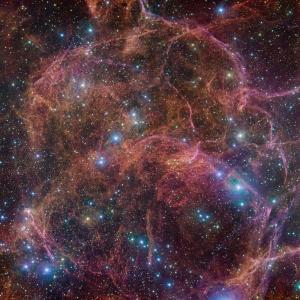Bright blue stars sparkle in front of the Vela Supernova Remnant--an expanding cloud of gas and dust from an exploded star in the southern constellation Vela, the sail. The star exploded roughly 11,000 years ago as seen from Earth. Today, the remnant is dozens of light-years across. Its debris swirls around as it encounters surrounding gas, dust, and magnetic fields. All that remains of the original star, which was many times the mass of the Sun, is a neutron star--a dense ball about twice the Sun's mass but no bigger than a city. This image, snapped with a telescope at the European Southern Observatory in Chile, contains more than 550 million pixels, and is the most detailed view of the Vela Supernova Remnant to date. [ESO/VPHAS+ team. Acknowledgement: Cambridge Astronomical Survey Unit]
You are here
Vela
The constellation Vela represents the sail of the Argo, the ship that carried Jason and the Argonauts. It’s quite low in the south as darkness falls this evening. Only one of its stars is much to look at. But if our eyes were more sensitive, we’d see that Vela is home to one of the largest individual objects in the night sky — the remains of an exploded star.
The Vela Supernova Remnant was born as little as 11,000 years ago as seen from Earth when a giant star exploded. The blast sent the star’s outer layers racing into space at a few percent of the speed of light.
This cloud of material continues to expand. Today, it’s dozens of light-years across. At a distance of about 800 light-years, that makes it look about as big as your fist held at arm’s length.
As the debris rams into surrounding clouds of gas and dust, it heats them and causes them to glow. That creates a thin but beautiful nebula. It contains a diverse brew of chemical elements created in the heart of the star, or in the supernova blast.
Not all of the star was destroyed, though. Its core was crushed to form a neutron star. This bizarre object is more than twice as heavy as the Sun, but only as wide as a mid-sized American city. It spins 11 times per second.
With each turn, a beam of radio energy sweeps across Earth, so the star “pulses” on and off — a pulsating beacon for the ancient Argo.
Script by Damond Benningfield
Get Premium Audio
Listen to today's episode of StarDate on the web the same day it airs in high-quality streaming audio without any extra ads or announcements. Choose a $8 one-month pass, or listen every day for a year for just $30.




